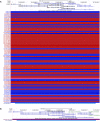The UCSC Genome Browser database: 2021 update
- PMID: 33221922
- PMCID: PMC7779060
- DOI: 10.1093/nar/gkaa1070
The UCSC Genome Browser database: 2021 update
Abstract
For more than two decades, the UCSC Genome Browser database (https://genome.ucsc.edu) has provided high-quality genomics data visualization and genome annotations to the research community. As the field of genomics grows and more data become available, new modes of display are required to accommodate new technologies. New features released this past year include a Hi-C heatmap display, a phased family trio display for VCF files, and various track visualization improvements. Striving to keep data up-to-date, new updates to gene annotations include GENCODE Genes, NCBI RefSeq Genes, and Ensembl Genes. New data tracks added for human and mouse genomes include the ENCODE registry of candidate cis-regulatory elements, promoters from the Eukaryotic Promoter Database, and NCBI RefSeq Select and Matched Annotation from NCBI and EMBL-EBI (MANE). Within weeks of learning about the outbreak of coronavirus, UCSC released a genome browser, with detailed annotation tracks, for the SARS-CoV-2 RNA reference assembly.
© The Author(s) 2020. Published by Oxford University Press on behalf of Nucleic Acids Research.
Figures









References
Publication types
MeSH terms
Grants and funding
LinkOut - more resources
Full Text Sources
Other Literature Sources
Medical
Research Materials
Miscellaneous

